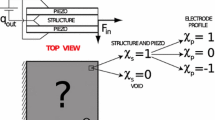Abstract
We investigate the occurrence of self-penalization in topology optimization problems for piezoceramic-mechanical composites. Our main goal is to give physical interpretations for this phenomenon, i.e., to study the question why for various problems intermediate material values are not optimal in the absence of explicit penalization of the pseudo densities. In order to investigate this effect numerical experiments for several static and/or dynamic actuator and sensor objective functions are performed and their respective results are compared. The objective functions are mean transduction, displacement, sound power, electric potential, electric energy, energy conversion and electric power.













Similar content being viewed by others
Notes
Solid Isotropic Material with Penalization
With imaginary unit j and ω = 2 πf.
References
Bendsøe MP (1989) Optimal shape design as a material distribution problem. Struct Multidisc Optim 1:193−202
Bendsøe MP, Sigmund O (2003) Topology optimization: theory, method and applications, 2nd edn. Springer
Diaz AR, Sigmund O (1995) Checkerboard patterns in layout optimization. Struct Multidisc Optim 10:40−45
Donoso A, Bellido J (2009) Systematic design of distributed piezoelectric modal sensors/actuators for rectangular plates by optimizing the polarization profile. Struct Multidisc Optim 38(4):347−356
Dühring MB (2009) Design of acousto-optical devices by topology optimization. In: Proceedings WCSMO-08, 1−5 June 2009. Lisbon, Portugal
Erturk A, Tarazaga P, Farmer J, Inman D (2009) Effect of strain nodes and electrode configuration on piezoelectric energy harvesting from cantilevered beams. Vibr Acoust 131(1):011010 (11 pages). doi:10.1115/1.2981094
Jensen JS (2007a) A note on sensitivity analysis of linear dynamic systems with harmonic excitation. Handout at DCAMM Advanced School, 20−26 June 2007 at DTU in Lyngby, Denmark
Jensen JS (2007b) Topology optimization of dynamics problems with Padé approximants. Int J Numer Methods Eng 72:1605−1630
Kaltenbacher M (2007) Numerical simulation of mechatronic sensors and actuators, 2nd edn. Springer, Berlin
Kaltenbacher B, Lahmer T, Mohr M, Kaltenbacher M (2006) PDE based determination of piezoelectric material tensors. Eur J Appl Math 17:383−416
Kögl M, Silva ECN (2005) Topology optimization of smart structures: design of piezoelectric plate and shell actuators. Smart Mater Struct 14(2):387−399
Rupitsch SJ, Lerch R (2009) Inverse method to estimate material parameters for piezoceramic disc actuators. Appl Phys A, Mater Sci Process 97(4):735−740
Rupp CJ, Evgrafov A, Dunn ML, Maute K (2009a) Topology optimization of piezoelectric energy harvesting structures and circuits. In: Proceedings WCSMO-08, 1−5 June 2009. Lisbon, Portugal
Rupp CJ, Evgrafov A, Maute K, Dunn ML (2009b) Design of piezoelectric energy harvesting systems: a topology optimization approach based on multilayer plates and shells. J Intell Mat Syst Str 20(16):1923−1939
Sigmund O (1994) Design of material structures using topology optimization. PhD thesis, Department of Solid Mechanics, Technical University of Denmark
Sigmund O (1997) On the design of compliant mechanisms using topology optimization. Mech Struct Mach 25(4):493−524
Sigmund O (2007) Morphology-based black and white filters for topology optimization. Struct Multidisc Optim 33(4):401−424
Sigmund O, Jensen JS (2003) Systematic design of phononic band-gap materials and structures by topology optimization. Philos Trans—Royal Soc, Math Phys Eng Sci 361(1806):1001−1019
Sigmund O, Petersson J (1998) Numerical instabilities in topology optimization: a survey on procedures dealing with checkerboards, mesh-dependencies and local minima. Struct Multidisc Optim 16:68−75
Silva ECN, Kikuchi N (1999) Design of piezoelectric transducers using topology optimization. Smart Mater Struct 8(3):350−364
Stainko R (2006) An adaptive multilevel approach to the minimal compliance problem in topology optimization. Commun Numer Methods Eng 22(2):109−118
Wang J, Ostergaard D, Inc A, Canonsburg P (1999) A finite element-electric circuit coupled simulation method forpiezoelectric transducer. In: Proceedings IEEE ultrasonics symposium, vol 2
Wein F, Kaltenbacher M, Schury F, Leugering G, Bänsch E (2008) Topology optimization of piezoelectric actuators using the SIMP method. In: Proceedings OIPE, 14−16 September 2009. TU Ilmenau, Germany, pp 46−47
Wein F, Kaltenbacher M, Leugering G, Bänsch E, Schury F (2009a) Topology optimization of a piezoelectric-mechanical actuator with single- and multiple-frequency excitation. Int J Appl Electromagn Mech 30(3−4):201−221
Wein F, Kaltenbacher M, Schury F, Bänsch E, Leugering G (2009b) Topology optimization of a piezoelectric loudspeaker coupled with the acoustic domain. In: Proceedings WCSMO-08, 1−5 June 2009. Lisbon, Portugal
Wein F, Weller E, Albach T, Sutor A, Lerch R (2009c) Topology optimization of a piezoelectric energy harvester. In: Proceedings sensor 2009, vol II
Weller E (2009) Topology optimization of a piezoelectric energy harvester. Master’s thesis, University of Erlangen-Nuremberg, Germany. In German
Zheng B, Chang CJ, Gea HC (2008) Topology optimization of energy harvesting devices using piezoelectric materials. Struct Multidisc Optim 38(1):17−23
Acknowledgements
The authors gratefully acknowledge the funding of the German Research Council (DFG) by the DFG Priority Program 1253 ‘Optimization with Partial Differential Equations’ through grants DFG06-381 and partially support within the framework of its ‘Excellence Initiative’ for the Cluster of Excellence ‘Engineering of Advanced Materials’ at the University of Erlangen-Nuremberg.
The authors would like to thank the anonymous reviewers for the helpful comments.
Author information
Authors and Affiliations
Corresponding author
Appendix: Material properties
Appendix: Material properties
The applied piezoelectric material is lead zirconate titanate PZT-5A with the following properties (in Voigt notation): mass density 7.75025 kg/m3, damping tanδ = 0.015 at 1,000 Hz, stiffness in GPa \(c_{11}^E=c_{22}^E=126\), \(c_{13}^E=79.5\), \(c_{23}^E=c_{22}^E=84.1\), \(c_{44}^E=c_{55}^E=c_{66}^E=23\), coupling in N/C e 15 = e 24 = 17, e 31 = e 32 = − 6.5, e 33 = 23.3, permittivity in 10 − 8 F/m \(\varepsilon_{11}^S=\varepsilon_{22}^S=1.51\), \(\varepsilon_{33}^S=1.27\).
The supporting aluminum plate has the following isotropic properties: Poisson’s ratio ν = 0.34, Young’s modulus E = 70.7 GPa, mass density 2.7 kg/m3, damping tanδ = 0.03 at 1,000 Hz.
For an accurate simulation model it might be necessary to determine the piezoelectric coupling coefficients by inverse methods as in Rupitsch and Lerch (2009).
Rights and permissions
About this article
Cite this article
Wein, F., Kaltenbacher, M., Kaltenbacher, B. et al. On the effect of self-penalization of piezoelectric composites in topology optimization. Struct Multidisc Optim 43, 405–417 (2011). https://doi.org/10.1007/s00158-010-0570-2
Received:
Revised:
Accepted:
Published:
Issue Date:
DOI: https://doi.org/10.1007/s00158-010-0570-2




